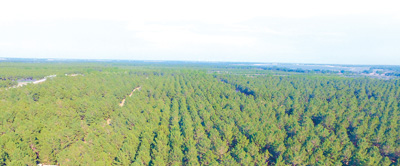County in NE China’s Heilongjiang sees amazing improvements in desertification control
Sand control efforts over the past 40 years have seen the forest coverage rate in Tailai county in northeast China’s Heilongjiang province, once plagued by desertification, increase from 3.7 percent in 1978 to 14 percent by the end of 2020.

File photo shows people planting a tree in sandy land in Daxing town, Tailai county, northeast China’s Heilongjiang province.
Located on the edge of the Horqin Sandy Land, the country’s largest sandy area, Tailai’s sandified land once reached 1.5 million mu (100,000 hectares). As of last year, the county has created 640,000 mu of forests, bringing its total forest area to 768,000 mu and its forest stock volume to 6.16 million cubic meters.
Feng Dexin is a local pioneer in afforestation. In 1974, then 19-year-old Feng settled in Keli village of the county’s Keli town with his three younger brothers. At that time, conditions were so harsh that sand even got into his mouth, Feng recalled, noting that sand dunes also encroached on farmland.
This prompted Feng and his brothers to enter into a contract with the local government for desertification control of 4,000 mu of land in 1985. Since then, they have braved countless trials and hardships and turned the sandy land into an oasis.
Feng is not the only sand fighter in Tailai. The county began to create farmland shelter forests and sand-fixing forests when China started to implement the Three-North Shelterbelt Forest Program, which included forestation measures in northwest, north and northeast China in 1978. It encouraged individuals to sign contracts with the government to combat desertification, resulting in the establishment of many family-run forest farms like Feng’s, according to Li Lianhai, an official from Tailai’s forestry and grassland bureau.
After years of exploration, Tailai has adopted targeted desertification control methods. The county’s Shiyu village in Daxing town, which has more than 500 mu of semi-fixed dunes, launched three afforestation projects after 2000, but all failed, Li said. Since April 2015, the village started to pave straw checkerboard sand barriers, plant pioneer tree species, enclose the forests to prevent deforesting and grazing, and apply high-efficiency irrigation technology. The approaches proved effective, and turned the barren sand into green land.

Aerial photo taken on Aug. 24, 2021 shows the 4,000 mu of trees planted by Feng Dexin, a villager in Keli village, Tailai county, northeast China’s Heilongjiang province. (Photo courtesy of the media convergence center of Tailai)
Tailai has also developed agriculture and animal husbandry in some sand-fixing forests, and has created low-density forests of evergreen and deciduous plants and grown Chinese medicinal herbs in woods.
In addition to Tailai’s success in taming desertification, the improvements have also brought economic benefits to people in the county.
Xi Xiuzhi, a 58-year-old resident in the county’s Xianjin village, is one of the locals to have benefited from the ecological improvements. In the past, Xi was forced to be a migrant worker because the food he grew in the sandy land was simply not enough to feed his family. In 2017, Xi returned to the village and has been working as a full-time forest ranger ever since, while his wife has become a cleaner in the village. The jobs bring the couple an annual income of more than 10,000 yuan ($1,549). Xi said there are 695 forest rangers like him in the county.
Over the past five years, Tailai’s three leading industries - livestock breeding and processing, health foods, and green energy - have been growing, said Zheng Deli, chief of the county, adding that Tailai has invested in the construction of 146 industrial projects, with a total investment of 10.85 billion yuan in fixed assets. Zheng noted that the county was lifted out of poverty in 2019.
Photos
 Dance show saluting traditional culture of the Song Dynasty makes its debut
Dance show saluting traditional culture of the Song Dynasty makes its debut Village in SW China’s Yunnan embraces prosperity through agricultural tourism
Village in SW China’s Yunnan embraces prosperity through agricultural tourism Eighth birthday for pair of giant pandas celebrated in Haikou, Hainan province
Eighth birthday for pair of giant pandas celebrated in Haikou, Hainan province Olympic gold medalists portrayed in Shanxi artist’s polymer clay sculptures
Olympic gold medalists portrayed in Shanxi artist’s polymer clay sculptures
Related Stories
- Ecological forests turns abandoned land green
- View of salt formations in southern part of Dead Sea
- China's Inner Mongolia gains ground in controlling desertification
- China's Inner Mongolia strives to combat desertification, improve ecological environment
- China's desertification efforts help restore harmony with nature
Copyright © 2021 People's Daily Online. All Rights Reserved.






